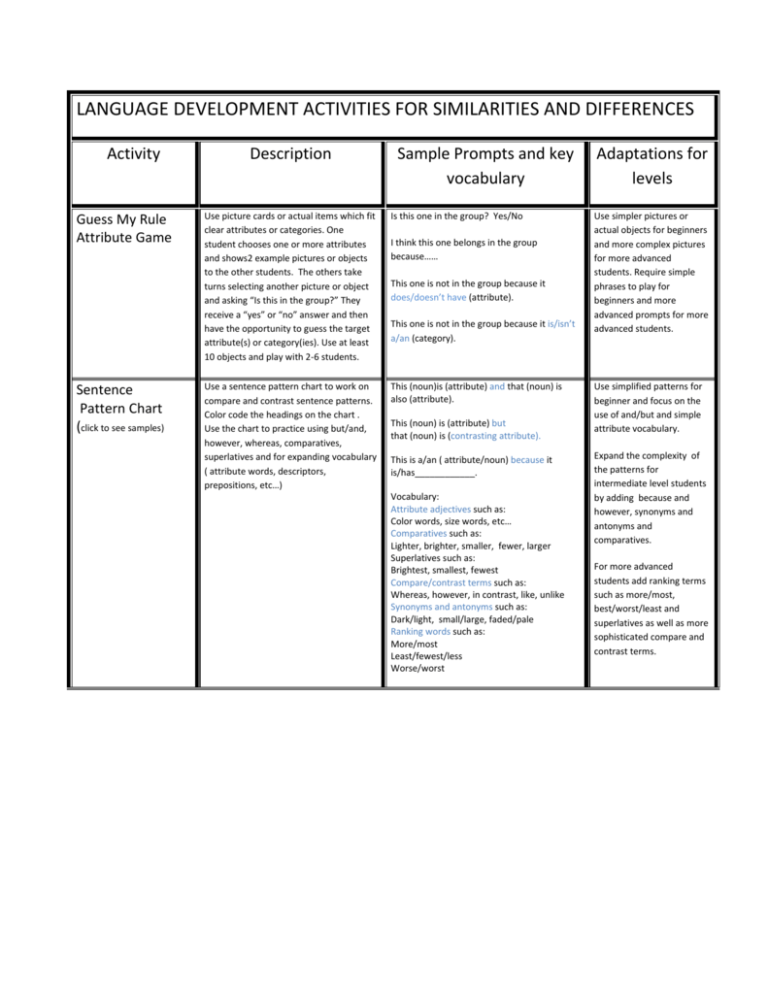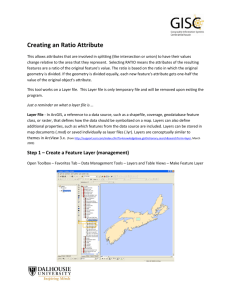doc
advertisement

LANGUAGE DEVELOPMENT ACTIVITIES FOR SIMILARITIES AND DIFFERENCES Activity Guess My Rule Attribute Game Sentence Pattern Chart (click to see samples) Description Sample Prompts and key vocabulary Use picture cards or actual items which fit clear attributes or categories. One student chooses one or more attributes and shows2 example pictures or objects to the other students. The others take turns selecting another picture or object and asking “Is this in the group?” They receive a “yes” or “no” answer and then have the opportunity to guess the target attribute(s) or category(ies). Use at least 10 objects and play with 2-6 students. Is this one in the group? Yes/No Use a sentence pattern chart to work on compare and contrast sentence patterns. Color code the headings on the chart . Use the chart to practice using but/and, however, whereas, comparatives, superlatives and for expanding vocabulary ( attribute words, descriptors, prepositions, etc…) This (noun)is (attribute) and that (noun) is also (attribute). I think this one belongs in the group because…… This one is not in the group because it does/doesn’t have (attribute). This one is not in the group because it is/isn’t a/an (category). This (noun) is (attribute) but that (noun) is (contrasting attribute). This is a/an ( attribute/noun) because it is/has____________. Vocabulary: Attribute adjectives such as: Color words, size words, etc… Comparatives such as: Lighter, brighter, smaller, fewer, larger Superlatives such as: Brightest, smallest, fewest Compare/contrast terms such as: Whereas, however, in contrast, like, unlike Synonyms and antonyms such as: Dark/light, small/large, faded/pale Ranking words such as: More/most Least/fewest/less Worse/worst Adaptations for levels Use simpler pictures or actual objects for beginners and more complex pictures for more advanced students. Require simple phrases to play for beginners and more advanced prompts for more advanced students. Use simplified patterns for beginner and focus on the use of and/but and simple attribute vocabulary. Expand the complexity of the patterns for intermediate level students by adding because and however, synonyms and antonyms and comparatives. For more advanced students add ranking terms such as more/most, best/worst/least and superlatives as well as more sophisticated compare and contrast terms. Categorizing Games Students work together in small groups to categorize the same set of objects. Then they compare their categorizations with those of other groups. To accomplish this, one student is chosen to stay and explain the rationale ( after practicing his/her speech with his/her whole group). The other students move as a team to visit all the groups’ work. Then the whole class comes back together to discuss the similarities and differences in the categorization of each group. This is a great way to work on explanation skills and to expand categorizing strategies and vocabulary. You can repeat the activity with the same materials and ask students to categorize them using different criteria. We placed the ____________ together because they all … We separated the ________from the _______ because … Ours is similar/different because…. Attribute adjectives such as: Color words, size words, etc… Comparatives such as: Lighter, brighter, smaller, fewer, larger Superlatives such as: Brightest, smallest, fewest Compare/contrast terms such as: Whereas, however, in contrast, like, unlike Synonyms and antonyms such as: Dark/light, small/large, faded/pale Ranking words such as: More/most Least/fewest/less Worse/worst A variation is for each group to have a distinct set of pictures/objects/words rotate them through each group. Another variation is for each person in the small group to have a turn categorizing and explaining and then pass it on to the next person who must categorize in a new way. Master Designer Barrier Game Use ATTRIBUTE BLOCKS which are trapezoids, triangles, circles, squares, rectangles and diamonds and come in specific colors. Distribute an equal number of each shape/size to each student. One student is the Master Designer and creates a simple design with the blocks behind a barrier (usually a file folder). The student then directs the others to build the same design. However, they get only verbal cues and they do not get to see the original design until the game is over. The goal is to have them build the same design. Be sure to explain that the designs will be made flat on the desktop and not in three dimensions! Compiled by Markowski 8/09 First place the (shape) in the center of your table or desk. Then (next, after that ….) place the ( shape) prepositional phrase the (shape). Vocabulary: Sequence words such as: First, then, next, after that prepositions such a : beside, above, below Prepositional phrases- such as: To the right of, to the left of, placed on the diagonal Shape words Trapezoid, rectangle, square, diamond/ rhombus, triangle Color words Blue, green, light green, white, red, etc… For beginning students keep the pictures/object groups small and the number of key attributes limited to three or fewer. For intermediate and advanced students you can increase the number of objects and the complexity of the attributes. You can add a writing layer and give a script or frame with blanks for the groups to complete. The group can fill in the script and practice reading or speaking it. This gives them all accountability for explaining. Then the specific student who sharing with other groups can use the script as a guide. Of course, you can vary the complexity of the script to suit the language levels of your students. This game is difficult because it involves giving precise directions. For beginning speakers chose only 3-4 shapes and limit the vocabulary-the prepositions- which can be used by the master designer.







